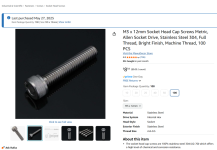Thomas McHale
New member
Anyone with experience in removing stripped screws from Weber gas control valves? Any help is appreciated.
See if you can gently heat the screw seatI'm having this problem right now with the central control valve of my E-310. I've tried soaking both the front & the (exposed) rear of the screw with PBlaster with no improvement. I really don't want to have to drill this out
How gentle we talking? I have a hot air gun that goes from 150º - 1200º Fahrenheit. That's a big rangeSee if you can gently heat the screw seat
The output is too broad from a heat gun. You need something with a pinpoint little flame something like this https://www.menards.com/main/tools/...ch/mt780/p-1571380066404-c-8533.htm?exp=falseHow gentle we talking? I have a hot air gun that goes from 150º - 1200º Fahrenheit. That's a big range
Oh, I also have a butane micro-torch! Just didn't think I'd want to use something that got that hot.The output is too broad from a heat gun. You need something with a pinpoint little flame something like this https://www.menards.com/main/tools/...ch/mt780/p-1571380066404-c-8533.htm?exp=false
I don't see hash marks. But I do see a little circle stamped in one of the "quadrants" of the screw head. I'll bust out my macro lens tomorrow and try to get a photo of it.There is a multi-page HOW-TO about cleaning and lubricating valves in the link below, and post #128 discusses that if the screws have hash marks on the screw head, they are actually Pozidrive screws, which are similar in appearance to Phillips head. If the head isn't completely cammed out, or for future use, a link for the correct bit is given. It's a good read.
Looking at the screws in the video, they are actually Pozidrive head screws. Those four hash marks indicate the Pozidrive, they are a a little broader bit and less chance of stripping the screw.
Is that on the green screw? Electrically, that generally indicates a grounding screw. There may be a ground symbol inside the circle if so.I don't see hash marks. But I do see a little circle stamped in one of the "quadrants" of the screw head. I'll bust out my macro lens tomorrow and try to get a photo of it.


